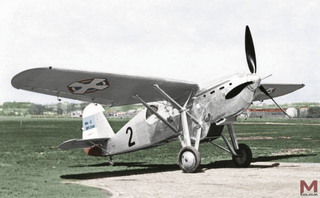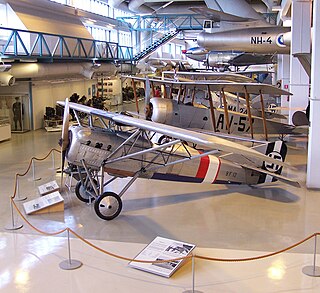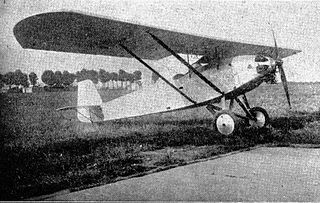
The Hansa-Brandenburg B.I was an unarmed military trainer and reconnaissance biplane of World War I, flown by the Austro-Hungarian Air Service. Early models were known internally to the Hansa-Brandenburg firm as the type D, while later models with a more powerful engine were designated FD. This aircraft was one of the earliest designs of Ernst Heinkel, who was working for Hansa-Brandenburg at the time. It was an entirely conventional two-bay biplane with staggered wings of unequal span. The pilot and observer sat in tandem in a long open cockpit.

The Ikarus IK-2 was a 1930s high-wing, single-seat, monoplane fighter aircraft of Yugoslav design built for the Royal Yugoslav Army Air Force. The IK-2 was designed by French-trained engineers Kosta Sivčev and Ljubomir Ilić, who saw the desirability of developing a home-grown aircraft industry. A gull-wing design, it was armed with a hub-firing autocannon and fuselage-mounted synchronised machine guns. Just 12 production models were built, as the aircraft was obsolescent at the time it was brought into service in 1935, and only eight were serviceable at the time of the German-led Axis invasion of Yugoslavia in April 1941. After the defeat of Yugoslavia, the remaining four aircraft were taken onto the strength of the air force of the Axis puppet state, the Independent State of Croatia, but none survived the war.

The Gourdou-Leseurre GL.2 was a French fighter aircraft which made its maiden flight in 1918.

The Spartan Cruiser was a 1930s British three-engined transport monoplane for 6 to 10 passengers built by Spartan Aircraft Limited at East Cowes, Isle of Wight. It was a development of the Saro-Percival Mailplane for passenger use.

The Dewoitine D.27 was a parasol monoplane fighter aircraft designed by Émile Dewoitine in 1928.

The Hanriot H.41 was a military trainer aircraft produced in France in the 1920s. It was a further development in the family of aircraft that had commenced with the HD.14 in 1920, and incorporated a number of design features that had been developed for other members of that family. Like those other aircraft, however, it was a conventional, two-bay biplane with unstaggered wings of equal span.

The Rogožarski PVT was a single-engined, two-seat parasol winged aircraft designed as an advanced and fighter trainer in Yugoslavia before World War II. Over 60 were built, serving with the Yugoslav Royal Air Force (YAF) until the fall of Yugoslavia in 1941. After that, some PVTs were used by the newly formed Air Force of the Independent State of Croatia, sometimes as ground attack aircraft.
The Zmaj R-1 was a twin-engined prototype bomber produced by Zmaj aircraft of the former Yugoslavia, designed in the 1930s. The aircraft remained a prototype due to a number of difficulties in testing.

The Fizir F1V was the basis from which engineer Rudolf Fizir developed a series of single-engined, two-seat, reconnaissance biplanes fitted with different engines. Construction was carried out in the Yugoslav aircraft factories Zmaj and Rogožarski between 1928 and 1932.

The Rogožarski SIM-X was a Yugoslav single-engine sports and tourist plane also used for basic training of military pilots designed in 1936, with two crew members. It was designed and built at the Rogožarski factory in Belgrade.
The SIM-VIII was a 1931 Yugoslav, single-engined, 2-seat, sport, tourist and training aircraft, designed by Sima Milutinović and built at the Rogožarski factory in Belgrade from 1931 and by Ikarus at Zemun from 1933.

Rogožarski Brucoš was a single-engine, two-seat, low wing monoplane aircraft designed as a trainer in Yugoslavia before World War II. It was designed and built in the Rogožarski aircraft factory in Belgrade.

The Rogožarski AŽR was a single-engined, two-seat biplane aircraft designed as a trainer in Yugoslavia before World War II. It was designed and built at the Rogožarski factory in Belgrade.

The Zmaj Fizir FN was a plane designed for primary (initial) training of pilots in Yugoslavia before World War II. It was constructed in Zmaj, a Zemun-based factory, in the Rogožarski factory in Belgrade, and Albatros in Sremska Mitrovica.

The Rogožarski SIM-VI was a single-engined, two-seat, low wing aircraft designed as trainer in Yugoslav before World War II. It was designed and built at the Rogožarski factory in Belgrade.

The SIM-II was a 1930s Yugoslav Sports and tourist plane and the plane for the basic training, one-engined, with two crew members. It was designed by Sima Milutinović and built at the "S.Vlajković i sinovi" factory in Belgrade.

Aircraft Zmaj Fizir FP-2 was a Yugoslav single-engine, two-seater biplane. It was designed by R. Fizir and D. Stankov built at the Factory Zmaj in Zemun in 1936.
The Ikarus 215 twin-engine plane, was a Yugoslav light bomber and a training aircraft of mixed construction, the prototype flew in 1949. It did not go into production. The prototype was used for training and as a liaison. It was designed and built at the Ikarus factory in Zemun-Belgrade.

The Ikarus MM-2 was a 1940 prototype single engine low-wing monoplane advanced training aircraft featuring mixed construction and retractable undercarriage produced at the Yugoslavian Ikarus factory.

Kingdom of Serbia became part of the new state, Kingdom of the Serbs, Croats and Slovenes. which was formed on 1 December 1918. Even though the industry was on a very low level of development, the state was among the first 10 countries in the world which developed their own aircraft production. Originally, only the parts produced in foreign factories were assembled, but very soon the production of domestic components began, so as the engineering. The forerunner of the domestic aircraft industry was the Airplane workshop, which was established in 1920, at the airfield in Novi Sad. The assembling of the trial series of Hansa-Brandenburg C.I. The series was named SBr, as this type of plane was known in Serbia as srednji Brandenburg.
















